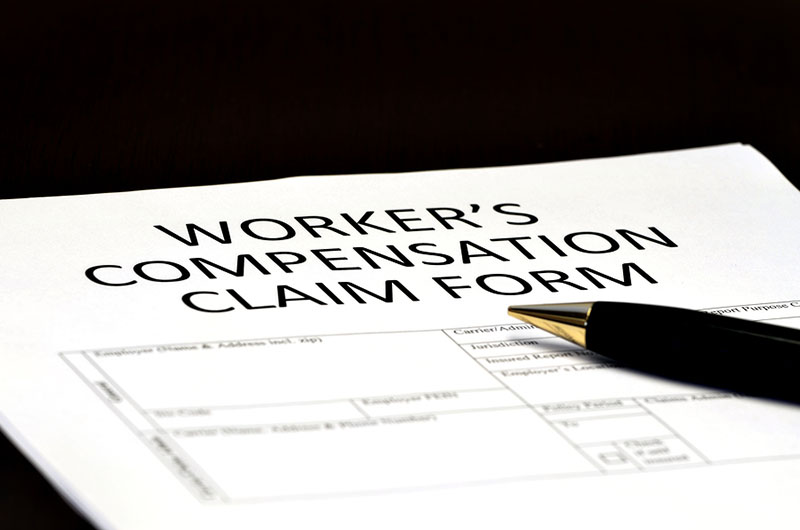As soon as you’re able, report your injury to your supervisor. Receive medical attention. Do so even if you don’t think that you were seriously injured. Then, file a workers compensation claim with your employer. If your initial claim is rejected, you can still receive compensation for your injuries.
You have a very specific timeline to do each of these. The sooner you do so, the better. These cases can become very complicated quickly. As such, you give yourself the best chance of success by involving an experienced attorney earlier in the process. Belal Hamideh can help you as he’s helped so many in the past to receive the workers’ compensation they deserve.
To schedule a free case evaluation with experienced work accident lawyer Belal Hamideh, message him through our site or call.

The Benefits of Hiring a Work Injury Compensation Attorney
Simply put, we can help you to recover the compensation you deserve. In California, your options might be limited. Typically, employers are protected from liability for injuries employees suffered while on duty. But, if your employer intentionally harmed you or acted in a manner likely to cause harm, you might have a legal basis to sue.
In certain cases, you could also consider suing a third party along with your employer if they contributed to your injury. For instance, if you’re a construction worker and a defective equipment piece hurts you, you could potentially sue the equipment’s manufacturer, designer, and others involved.
Immediately consult with a knowledgeable workers’ compensation attorney after your incident. To set up a consultation with Belal Hamideh, use the contact methods provided on this site.
The Benefit of a Worker’s Compensation Attorney
Engaging a skilled personal injury attorney from California greatly enhances your chances of winning your case. These experts are well-versed in court proceedings, the legal system, and specifically personal injury laws.
A seasoned lawyer can provide you with accurate advice on your claim’s worth, making sure you receive compensation for all potential damages, including punitive, economic, emotional distress, and others. An attorney can also save you important time, allowing you to concentrate on your recovery.
What Types of Cases Does a Personal Injury Attorney Manage?
Personal injury attorneys in California typically manage a broad array of vehicle accident cases, such as:
- Motor Vehicle Accidents: Drivers are required to demonstrate “duty of care” on the road. If their negligent or reckless actions cause injury to you, you’re entitled to compensation.
- Pedestrian, Bike, Motorcycle, and Truck Accidents: If you’re injured in these situations, our extensive experience can help secure the compensation you deserve.
- Dog Bite Injuries: Even minor dog bites can lead to lasting damage and serious complications.
- Slip and Fall Accidents: If you’ve been injured due to a slip or fall on someone else’s property, you might be eligible for compensation.
- Construction Site Accidents: If your injury at a construction site resulted from negligence by an employee from another company, you can lodge a personal injury claim against that company.
- Rideshare Accidents: As a passenger or driver in an Uber or Lyft vehicle, you can claim compensation from their insurance policies if you’re involved in an accident.
- Wrongful Death: Although no compensation can truly compensate for the tragic loss of a loved one, we can fight to ensure you’re compensated for the pain you’ve endured.

What Should You Do After an Accident?
Firstly, try to stay as calm as possible. Ensure your safety, which might include moving your vehicle away from danger or staying away from potential hazards. Notify the law enforcement but first check any injuries to see if immediate medical help is necessary.
If you’re physically unharmed, try to document the incident in detail. Exchange relevant information like contact and insurance details with other parties involved and take as many photos as you can. Identify any possible witnesses and collect their information. A crucial but often forgotten point: Avoid admitting fault or apologizing until the case is under review.
What Does it Cost to Hire a Personal Injury Lawyer?
Let’s simplify this: We operate on a contingency fee basis, eliminating the need for upfront payment. There’s no necessity to deplete your finances to secure the services of Belal Hamideh, your personal injury lawyer. His fee comes from your compensation, a concept known as “contingency fee”.
This means our fee directly reflects the amount you garner from your settlement/victory. In other words, if we don’t win your case, we don’t earn. Therefore, we’re highly motivated to represent your case enthusiastically.
What’s the Average Personal Injury Settlement Value?
There isn’t a fixed value for a personal injury settlement, as all cases and injuries have their unique attributes. Nonetheless, Belal Hamideh Law has consistently won millions for our clientele. Factors such as medical costs, lost earnings, as well as physical and emotional distress caused by the accident influence the settlement sum. We’re dedicated to relentlessly pursuing the maximum compensation for your injuries.
How Long Does a Personal Injury Case Last?
Negotiations with an insurance company typically last between one to twelve weeks. If a reasonable offer is put forth early, the claim settles quicker. If the insurance company prefers to lowball, we’ll discuss with you whether to take their final offer or take them to court. Just a meager two percent of cases end up in court, as insurance companies lean towards quick settlements. If a lawsuit becomes necessary, your claim can be settled at any point before the trial commences.
Who Can Be Sued for My Injuries?
It’s possible to sue anyone accountable for your injuries. We can leverage our extensive resources to carry out a comprehensive investigation into your accident to identify the culpable parties accurately and sue them. Mostly, these parties include negligent/reckless drivers, employers, vehicle owners, property owners, repair shops, public entities, product manufacturers and designers, among others.
Can I Claim Compensation if I’m Partly At Fault?
Yes, you can still claim compensation even if you’re partially to blame. Under “comparative negligence”, your compensation will be reduced according to your degree of fault in the accident. For example, if you’re 25% at fault in a motorcycle accident, you could yet receive 75% of the compensation rendered.
Engage the Leading Personal Injury Attorney in California
Managing a personal injury is particularly stressful. With an experienced personal injury attorney on your side, you can focus on your healing while we fight for the compensation you rightfully deserve.
Laws to Know in Regards to a Work Injury
The following laws may be pertinent to your work injury situation.
California Code, Labor Code – LAB § 3600
(a) Liability for the compensation provided by this division, in lieu of any other liability whatsoever to any person except as otherwise specifically provided in Sections 3602, 3706, and 4558, shall, without regard to negligence, exist against an employer for any injury sustained by his or her employees arising out of and in the course of the employment and for the death of any employee if the injury proximately causes death, in those cases where the following conditions of compensation concur:
(1) Where, at the time of the injury, both the employer and the employee are subject to the compensation provisions of this division.
(2) Where, at the time of the injury, the employee is performing service growing out of and incidental to his or her employment and is acting within the course of his or her employment.
(3) Where the injury is proximately caused by the employment, either with or without negligence.
(4) Where the injury is not caused by the intoxication, by alcohol or the unlawful use of a controlled substance, of the injured employee. As used in this paragraph, “controlled substance” shall have the same meaning as prescribed in Section 11007 of the Health and Safety Code.
(5) Where the injury is not intentionally self-inflicted.
(6) Where the employee has not willfully and deliberately caused his or her own death.
(7) Where the injury does not arise out of an altercation in which the injured employee is the initial physical aggressor.
(8) Where the injury is not caused by the commission of a felony, or a crime which is punishable as specified in subdivision (b) of Section 17 of the Penal Code, by the injured employee, for which he or she has been convicted.
(9) Where the injury does not arise out of voluntary participation in any off-duty recreational, social, or athletic activity not constituting part of the employee’s work-related duties, except where these activities are a reasonable expectancy of, or are expressly or impliedly required by, the employment. The administrative director shall promulgate reasonable rules and regulations requiring employers to post and keep posted in a conspicuous place or places a notice advising employees of the provisions of this subdivision. Failure of the employer to post the notice shall not constitute an expression of intent to waive the provisions of this subdivision.
(10) Except for psychiatric injuries governed by subdivision (e) of Section 3208.3, where the claim for compensation is filed after notice of termination or layoff, including voluntary layoff, and the claim is for an injury occurring prior to the time of notice of termination or layoff, no compensation shall be paid unless the employee demonstrates by a preponderance of the evidence that one or more of the following conditions apply:
(A) The employer has notice of the injury, as provided under Chapter 2 (commencing with Section 5400), prior to the notice of termination or layoff.
(B) The employee’s medical records, existing prior to the notice of termination or layoff, contain evidence of the injury.
(C) The date of injury, as specified in Section 5411, is subsequent to the date of the notice of termination or layoff, but prior to the effective date of the termination or layoff.
(D) The date of injury, as specified in Section 5412, is subsequent to the date of the notice of termination or layoff.
For purposes of this paragraph, an employee provided notice pursuant to Sections 44948.5, 44949, 44951, 44955, 72411, 87740, and 87743 of the Education Code shall be considered to have been provided a notice of termination or layoff only upon a district’s final decision not to reemploy that person.
A notice of termination or layoff that is not followed within 60 days by that termination or layoff shall not be subject to the provisions of this paragraph, and this paragraph shall not apply until receipt of a later notice of termination or layoff. The issuance of frequent notices of termination or layoff to an employee shall be considered a bad faith personnel action and shall make this paragraph inapplicable to the employee.
(b) Where an employee, or his or her dependents, receives the compensation provided by this division and secures a judgment for, or settlement of, civil damages pursuant to those specific exemptions to the employee’s exclusive remedy set forth in subdivision (b) of Section 3602 and Section 4558, the compensation paid under this division shall be credited against the judgment or settlement, and the employer shall be relieved from the obligation to pay further compensation to, or on behalf of, the employee or his or her dependents up to the net amount of the judgment or settlement received by the employee or his or her heirs, or that portion of the judgment as has been satisfied.
(c) For purposes of determining whether to grant or deny a workers’ compensation claim, if an employee is injured or killed by a third party in the course of the employee’s employment, no personal relationship or personal connection shall be deemed to exist between the employee and the third party based only on a determination that the third party injured or killed the employee solely because of the third party’s personal beliefs relating to his or her perception of the employee’s race, religious creed, color, national origin, age, disability, sex, gender, gender identity, gender expression, or sexual orientation.
